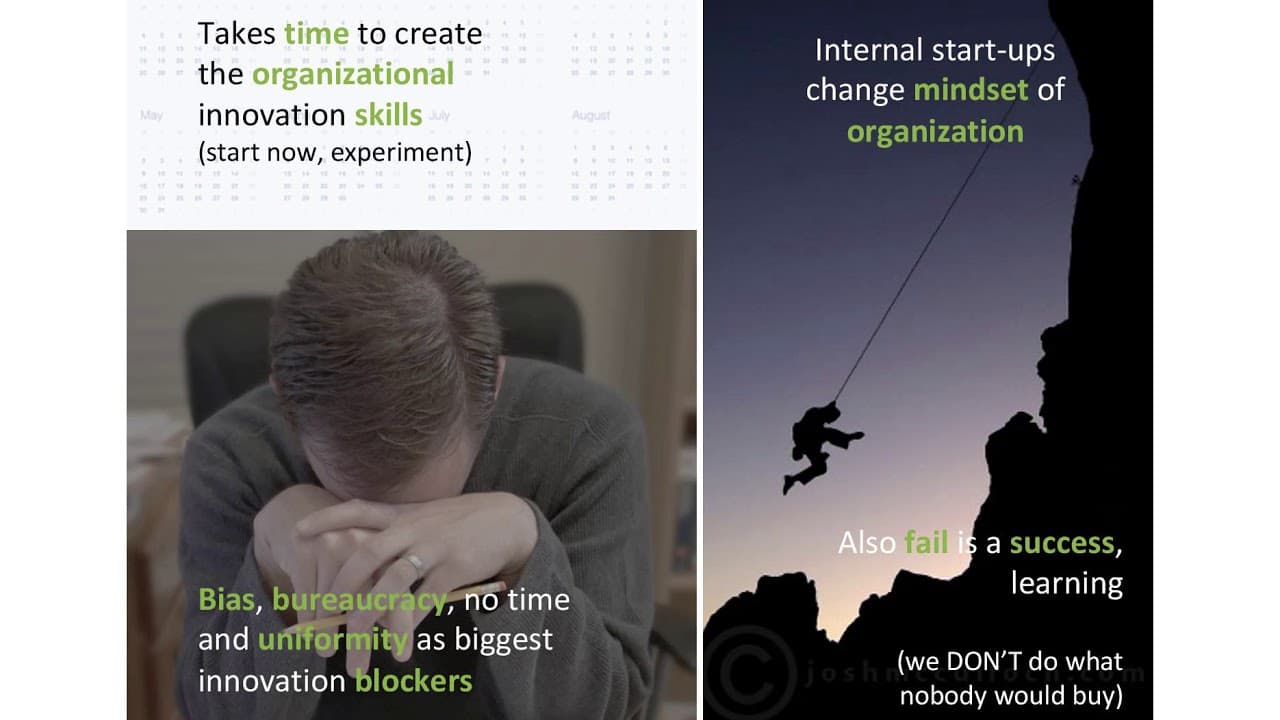I want to talk about innovation culture and my experience with innovation. This experience varies across different companies, but I have tried to summarize it into some key phases and anti-patterns that I will discuss today.
About Me
I primarily work as a media and innovation coach, helping not only to start my own companies but also assisting others in launching their businesses and internet startups. What I share here comes from both my personal experience and discussions with others in the field.
Phases of Agile and Innovation Transformation
When implementing an Agile transformation, it's important to understand that it's not just about development or ideas—it’s about corporate and organizational change. It’s a mindset shift. Innovation itself is a subset of this broader cultural transformation.
Because innovation is an organizational change, it must be connected, supported, and driven by the business. Just as HR is evolving, so is Agile. If we compare it to manufacturing, which has been around for thousands of years, software development is still in its early stages—just 50-60 years old. Agile, as we understand it today, is still evolving. What we discuss today as best practices may be very different in the future.
Evolution of Soft Skills and Innovation
Who remembers when soft skills were not even discussed in software development five or ten years ago? Only a few hands go up. This shows how the field evolves, and startups and innovation are just part of this ongoing change. My personal guess is that we are still in a "teenage" phase, far from full maturity in Agile and innovation.
It’s important to note that the phases of transformation do not always happen sequentially—they often run in parallel and are interwoven.
Phases of Agile Transformation
1. Internal Cleaning
Most Agile transformations start internally, typically within IT teams. The key goal at this stage is improving delivery—speed, quality, and engineering practices (such as XP and Scrum). The objective is to create visibility for the rest of the business, moving away from the "black hole" perception of IT.
2. Dismantling the Wall
The next step is bridging the gap between IT and business. This is where real discussions about value begin. Business and IT teams start collaborating, with demo sessions and success being measured in terms of business value rather than just technical output (e.g., story points). Incremental innovations emerge as teams refine processes or add features that directly address business needs.
3. IT as Part of the Business
In this phase, IT and business sit together, understand each other’s constraints, and integrate processes like Dual-Track Agile or discovery-driven development. Instead of building unnecessary features, the focus is on validating needs before development. This can significantly speed up development and reduce wasted effort.
4. Business-Driven by Technology
At the most advanced stage, the business is fully technology-driven. Incremental innovation becomes part of daily work, as seen in industries like finance. Here, Agile procurement and adaptive management take center stage, enabling continuous evolution.
The McKinsey Three Horizons Model
Companies need to think in terms of three horizons:
- Horizon 1: Current business—this is the cash cow.
- Horizon 2: Next-generation products—these have been validated but are not yet core business.
- Horizon 3: Emerging products—these are in the exploration phase, searching for a viable business model.
Innovation Blockers
When starting an innovation journey, the first step is identifying blockers. Common ones include:
- Confirmation bias: "We already know what the customer wants."
- Bureaucracy: "Fill in this 15-page form before innovating."
- No time: "You need to innovate but also do all your usual tasks."
- Uniformity: Expecting the same mindset across all teams instead of embracing diversity.
Who is Your Customer?
Using Geoffrey Moore's Crossing the Chasm model, companies must understand whether they are early adopters or part of the majority. Highly innovative companies must invest in H2 and H3 initiatives, while more traditional businesses can focus on industrializing existing innovations.
Encouraging Innovation
Here are a few practical approaches:
- Invite stakeholders and end-users to demos for direct feedback.
- Use data to drive decisions rather than opinions.
- Encourage experimentation with small tests—e.g., adding a feature toggle to measure interest before full development.
- Organize hackathons, innovation days, and structured "FedEx days" to foster creative thinking.
- Ensure innovation efforts are fully dedicated, rather than squeezed in between regular work.
Anti-Patterns in Innovation
1. The "Explicit No" Culture
Innovation often fails because ideas are dismissed outright. Instead, create an "Explicit Yes" approach, allocating dedicated time for experimentation.
2. Highest-Paid Person’s Opinion (HiPPO) Bias
Decisions should be based on real user data, not just the opinion of the most senior person in the room.
3. Expecting Everyone to be Innovative
Not every role requires radical innovation. Teams responsible for maintaining stability should focus on incremental improvements.
4. Over-Reliance on External Innovation Agencies
While external agencies bring fresh ideas, internal teams must be involved to ensure ownership and continuity.
5. Innovation Without a Business Model
Many great technologies (e.g., Google Glass, early Twitter) struggled due to a lack of a viable business model. Always consider customer needs, product feasibility, and business sustainability.
6. Innovation Creating Internal Divides
Innovation teams should not become isolated. Treat the internal organization as a "second customer," ensuring collaboration between new initiatives and existing business units.
Final Thoughts
Innovation is a long-term journey. Start small, act immediately, and integrate it into daily work. If you’d like to read more, I wrote a book on this topic a few years ago, which provides further details. You can download it at the link below:



